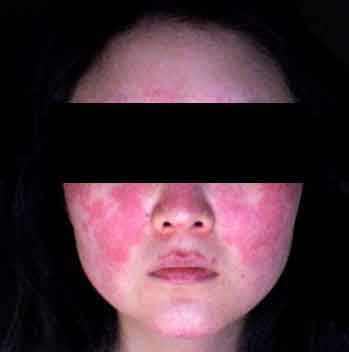
| SYSTEMIC LUPUS ERYTHEMATOSUS (SLE) |
History Rheumatic diseases affect joints, muscles and other parts of the body, and often involve abnormalities of the immune system. Lupus can affect not only joints and muscles but also skin, kidneys, nervous system, lungs, heart and the blood-forming organs. Lupus is an autoimmune disease in which the tissues of the body are attacked by the overly active immune system and is treated by suppressing the immune system. There are two common forms of lupus: discoid and systemic. Discoid lupus is a disease of the skin which is often chronic and leads to scarring. It may be limited to the skin and not be associated with disease in any other body systems. In other cases, discoid lupus may be one of the features of the systemic form of lupus. This information focuses on the systemic form of the disease. |
| Prognosis and impacts
Lupus may be a mild disorder in some people, but for others it can lead to serious problems. Each person is different, and what is true about someone else's disease may not apply to you. Lupus is a chronic, systemic, inflammatory disease. Chronic means it lasts a long time, probably for the rest of your life. However, nearly all people with lupus have fluctuations in disease activity known as flares and remissions. At times there may be no signs or symptoms of lupus at all (remissions). Some people have complete and long-lasting remissions. A systemic disease is one in which many different parts of the body may be affected. Inflammatory refers to a reaction of the body resulting in pain, heat, redness and swelling. Although lupus is a chronic disease, this doesn't mean you can't live a full life. Chronic diseases can't be Treatmentd but they can be controlled through proper treatment. Special concerns for people with lupus People with lupus are more likely to develop infections. This is true partly because of the illness itself, and partly because of the side effects of medications, especially corticosteroids and immunosuppressive drugs. In some people with lupus, infections can trigger disease flares. Exposure to the sun and fluorescent lighting is known to make the skin rashes associated with lupus worse in most people. Sun exposure may also cause generalized flares of lupus, resulting in fevers, joint pains, or even inflammation involving the heart, lungs, kidneys or nervous system. Of course, what is too much sun for one person may be fine for someone else. However, it's best to take simple precautions. These include regularly using a sunscreen lotion or sun block on your skin and avoiding outdoor activities during peak sunlight hours (usually 10 am to 4 pm). Sunscreens may be bought without a prescription, and are available in many different forms, some of which also include skin lubricants. Those with a sun protection factor of 15 or more are the best. Some chemicals in sunscreens may cause skin irritation or rashes, so it is important to try a different type of preparation if this occurs. During unavoidable times of sun exposure, it is important to wear a hat to shade you from direct sun and clothing to cover the arms, legs and chest. Because of possible problems from sun exposure, you may wonder if it is safe to move to a warmer climate. As long as you protect yourself when you go out in the sun, your illness should not affect where you live.
|
Incidence and risk factors
|
How is lupus diagnosed? Because symptoms vary so widely from patient to patient, and because symptoms mimic the symptoms of many other diseases, diagnosis of systemic lupus erythematosus can be difficult.
|
What are the symptoms of lupus? Patients with SLE can develop different combinations of symptoms and organ involvement. Common complaints and symptoms include fatigue, low-grade fever, loss of appetite, muscle aches, arthritis, ulcers of the mouth and nose, facial rash ("butterfly rash"), unusual sensitivity to sunlight (photosensitivity), inflammation of the lining that surrounds the lung(pleuritis) and the heart (pericarditis), and poor circulation to the fingers and toes with cold exposure (Raynaud's phenomenon). More serious organ involvement with inflammation occurs in the brain, liver, and kidney. White blood cells and blood clotting factors also can be decreased in SLE, thereby increasing the risk of infection and bleeding. Over half of the patients with SLE develop a characteristic red, flat facial rash over the bridge of their nose. Because of its shape, it is frequently referred to as the " butterfly rash" of SLE. The rash is painless and does not itch. The facial rash, along with inflammation in other organs, can be precipitated or worsened by exposure to sunlight, a condition called photosensitivity. This photosensitivity can be accompanied by worsening of inflammation throughout the body, called a "flare" of disease.
|
| Treatment
SLE is a chronic disease with no modern herbal medicine Treatment, so medications that modulate the immune system (primarily corticosteroids and immunosuppressant steroid) are used to control the disease and prevent re-occurrence of symptoms (known as flares). Alternative medicine reportsTraditional Chinese Master Herbs may be useful in the treatment of lupus. A 1985 study on lupus and acupuncture reported improvement of lupus sufferers over matched controls, though there was no placebo group for comparison. It is possible that acupuncture may be useful for the treatment some of the symptoms of lupus, but there need to be more research done before a definitive statement can be made regarding acupuncture, and alternative herbal medicine as a whole.
|
|
 |

